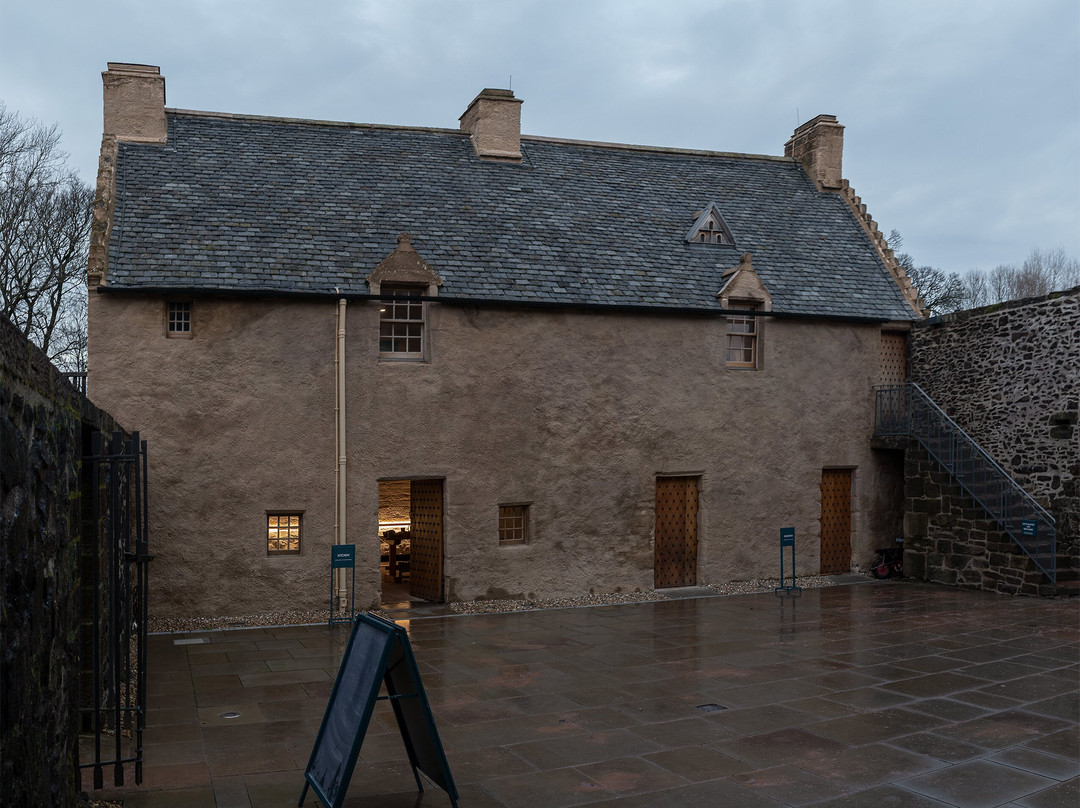的点评
This small ancient venue packs a mighty punch as a national and local asset
Provan Hall的点评
点评:A friend and I decided to spend a grey dreich Sunday by visiting one of the places long on our list of local places – Provan Hall. Often called Provan’s Hall, is only ten miles from where we live.
Believed to date from the mid-1500s or thereby, the building is considered to be the second-oldest ‘house’ in the Glasgow city area, not including towerhouses. The oldest is believed to be Provand’s Lordship from the late 1400s, situated on Glasgow’s High Street. They both share a close relationship as properties owned and administered by the pre-Reformation bishops of Glasgow Cathedral. The estate seems to be attested at least as early as the 1460s when a prebendal building may have existed close by for the administration and residence on the estate. But the oldest present building is stylistically dated to the mid-16th century. Recent dendro-dating of a timber in the building has revealed an AD 1200s date, which may suggest an earlier settlement existed on the same site in that period, depending on how local the wood was sourced from, and how recent the tree containing it was felled.
Speaking of the wider Scottish importance of Provan Hall, it is clearly one of the most important if not the most important examples of a pre-Reformation defended homestead surviving in Scotland. We have many important pre-Reformation examples of non-castellated domestic architecture, but very little like Provan Hall.
When we arrived in the vicinity for our visit—now a sprawling road network and retail metropolis—the vision of Provan Hall stood out prominently. The warm-hued harling of the building and its understated landscaped setting seemed like an oasis amongst all the bustle.
Getting closer, we found ample free parking available. In the building the very attentive and knowledgeable guide/caretaker impressed us with their diverse and precise knowledge of the history of the building. It was clear that this was not only adequately informed as part of their role, but was also grounded in a clear sense of Scottish history. This is becoming a rare trait.
The buildings have undergone a major restoration and repurposing in recent times. It serves as an architectural monument with audio-visual presentations, while the late-1700s house (that replaced Provan Hall) is put to wider community and meeting space use and is called the ‘welcome hub’. The restoration harling on the building is quite recent and authentic. This covers the stained rubble-built construction and helps further waterproof it. It is clearly well executed.
The display boards inside one of the vaulted chambers gives a very accessible storyline of Provan Hall through the ages, while the projected video shorts in other rooms provide bite-size snippets of its history into recent times.
The staff are clearly passionate and enthusiastic, and this element really brings the place to life as a cherished community asset. People who live in the area must smile and carry their head a little higher when they pass this old friend.
For something of this scale and purpose, it punches very high indeed. People seeking an extensive and well-stocked museum experience should not be looking for Provan Hall to fulfil it. It is not that sort of venue. However, it is clear that the building contains nothing in the way of authentic artefacts – the bed seeming to be a modern reconstruction in an older style. The venue would probably stand to gain from some NTS and Glasgow Museums partnership to host items from the correct period that may have been in a place like Provan Hall. For example, furniture and paintings and other objects. Admittedly this would require better and more constant atmospheric, security and manual surveillance, but it would be a major improvement.
It is also clear that some updating is needed on the website. Despite the often well researched quality of the many volunteer blogs and overall guidance, some details undermine the prestige and credibility of the website. For example, by no stretch of the imagination can the oldest parts of the complex be called ‘Medieval’. It is clear we are dealing with a post-Medieval or Scottish Renaissance building, depending on one’s preference. Better consistency contextualisation of the AD 1460 or AD 1470s date in relation to the mid-1500s building, would also contribute to refining matters. Tidying up of these details would add a nice polish to an already well put together community enterprise.
Apart from this, the only other detraction was the prison like modern metal fence. Its green colouration does nothing to hide it. One item like this really impacts on the ambience of the building, but it is clear that some form of perimeter is needed to security out of hours. A compromise could be to plant trailing willow or similar in a woven fashion to integrate with the boundary fence and blend it with the gardens. Otherwise, a dense and secure topiary hedge could be planted, and once mature enough, then the fence could be removed, retaining the gate for secure entry.
We had no proper chance to see the lovely gardens laid out beside the buildings. We decided that spring and summer would be an ideal time to return. We did, however, appreciate what remains of the terraced garden fronting the later house. This looks out onto a small loch – really a pond within a municipal park.
We also saw clear evidence of the various events and re-enactments that take place throughout the year from time to time. We plan to return to see these during the busier warm season.
Access to the buildings was free, although donations are welcomed.
Believed to date from the mid-1500s or thereby, the building is considered to be the second-oldest ‘house’ in the Glasgow city area, not including towerhouses. The oldest is believed to be Provand’s Lordship from the late 1400s, situated on Glasgow’s High Street. They both share a close relationship as properties owned and administered by the pre-Reformation bishops of Glasgow Cathedral. The estate seems to be attested at least as early as the 1460s when a prebendal building may have existed close by for the administration and residence on the estate. But the oldest present building is stylistically dated to the mid-16th century. Recent dendro-dating of a timber in the building has revealed an AD 1200s date, which may suggest an earlier settlement existed on the same site in that period, depending on how local the wood was sourced from, and how recent the tree containing it was felled.
Speaking of the wider Scottish importance of Provan Hall, it is clearly one of the most important if not the most important examples of a pre-Reformation defended homestead surviving in Scotland. We have many important pre-Reformation examples of non-castellated domestic architecture, but very little like Provan Hall.
When we arrived in the vicinity for our visit—now a sprawling road network and retail metropolis—the vision of Provan Hall stood out prominently. The warm-hued harling of the building and its understated landscaped setting seemed like an oasis amongst all the bustle.
Getting closer, we found ample free parking available. In the building the very attentive and knowledgeable guide/caretaker impressed us with their diverse and precise knowledge of the history of the building. It was clear that this was not only adequately informed as part of their role, but was also grounded in a clear sense of Scottish history. This is becoming a rare trait.
The buildings have undergone a major restoration and repurposing in recent times. It serves as an architectural monument with audio-visual presentations, while the late-1700s house (that replaced Provan Hall) is put to wider community and meeting space use and is called the ‘welcome hub’. The restoration harling on the building is quite recent and authentic. This covers the stained rubble-built construction and helps further waterproof it. It is clearly well executed.
The display boards inside one of the vaulted chambers gives a very accessible storyline of Provan Hall through the ages, while the projected video shorts in other rooms provide bite-size snippets of its history into recent times.
The staff are clearly passionate and enthusiastic, and this element really brings the place to life as a cherished community asset. People who live in the area must smile and carry their head a little higher when they pass this old friend.
For something of this scale and purpose, it punches very high indeed. People seeking an extensive and well-stocked museum experience should not be looking for Provan Hall to fulfil it. It is not that sort of venue. However, it is clear that the building contains nothing in the way of authentic artefacts – the bed seeming to be a modern reconstruction in an older style. The venue would probably stand to gain from some NTS and Glasgow Museums partnership to host items from the correct period that may have been in a place like Provan Hall. For example, furniture and paintings and other objects. Admittedly this would require better and more constant atmospheric, security and manual surveillance, but it would be a major improvement.
It is also clear that some updating is needed on the website. Despite the often well researched quality of the many volunteer blogs and overall guidance, some details undermine the prestige and credibility of the website. For example, by no stretch of the imagination can the oldest parts of the complex be called ‘Medieval’. It is clear we are dealing with a post-Medieval or Scottish Renaissance building, depending on one’s preference. Better consistency contextualisation of the AD 1460 or AD 1470s date in relation to the mid-1500s building, would also contribute to refining matters. Tidying up of these details would add a nice polish to an already well put together community enterprise.
Apart from this, the only other detraction was the prison like modern metal fence. Its green colouration does nothing to hide it. One item like this really impacts on the ambience of the building, but it is clear that some form of perimeter is needed to security out of hours. A compromise could be to plant trailing willow or similar in a woven fashion to integrate with the boundary fence and blend it with the gardens. Otherwise, a dense and secure topiary hedge could be planted, and once mature enough, then the fence could be removed, retaining the gate for secure entry.
We had no proper chance to see the lovely gardens laid out beside the buildings. We decided that spring and summer would be an ideal time to return. We did, however, appreciate what remains of the terraced garden fronting the later house. This looks out onto a small loch – really a pond within a municipal park.
We also saw clear evidence of the various events and re-enactments that take place throughout the year from time to time. We plan to return to see these during the busier warm season.
Access to the buildings was free, although donations are welcomed.
翻译:我和一位朋友决定在一个阴沉的星期天去参观我们当地景点清单上很长的一个地方——普罗文大厅。普罗文大厅通常被称为普罗文大厅,距离我们住的地方只有十英里。
据信这座建筑建于 1500 年代中期,被认为是格拉斯哥市区第二古老的“房子”,不包括塔楼。最古老的建筑被认为是 1500 年代后期的普罗文领主领地,位于格拉斯哥大街。它们都关系密切,都是格拉斯哥大教堂前主教拥有和管理的财产。该庄园似乎至少可以追溯到 1460 年代,当时附近可能存在一座俸禄建筑,用于庄园的管理和居住。但目前最古老的建筑在风格上可以追溯到 16 世纪中叶。最近对建筑物中木材的树木年代测定显示其年代为公元 1200 年代,这可能表明当时在同一地点存在更早的定居点,具体取决于木材的来源地以及包含木材的树木被砍伐的时间。
说到 Provan Hall 对苏格兰更广泛的重要性,它显然是苏格兰现存的宗教改革前防御宅基地中最重要的例子之一,如果不是最重要的例子的话。我们有许多重要的宗教改革前非城垛式住宅建筑的例子,但很少有像 Provan Hall 这样的。
当我们到达附近进行参观时——现在是一个庞大的道路网络和零售大都市——Provan Hall 的景象引人注目。建筑的暖色调和低调的景观环境似乎是喧嚣中的一片绿洲。
走近后,我们发现有充足的免费停车位。在建筑中,非常细心和知识渊博的导游/看护人给我们留下了深刻的印象,他们对建筑历史有着广泛而精确的了解。很明显,这不仅是他们工作的一部分,而且是建立在对苏格兰历史的清晰认识之上的。这正在成为一种罕见的特质。
这些建筑最近经历了大规模的修复和重新利用。它作为一座建筑纪念碑,配有视听演示,而 18 世纪后期的房子(取代了 Provan Hall)则被用作更广泛的社区和会议空间,被称为“欢迎中心”。对建筑的修复是相当新近和真实的。这覆盖了沾满污渍的瓦砾建筑,并有助于进一步防水。显然,它做得很好。
其中一个拱形房间内的展示板非常容易理解地讲述了 Provan Hall 各个时代的故事情节,而其他房间中放映的视频短片则提供了其近代历史的简短片段。
工作人员显然充满热情和热情,这一因素确实使这个地方成为珍贵的社区资产。住在该地区的人们经过这个老朋友时一定会微笑并抬起头。
对于这种规模和目的的东西,它确实非常令人印象深刻。寻求广泛且藏品丰富的博物馆体验的人不应该在 Provan Hall 寻找这样的体验。它不是那种场所。然而,很明显,这座建筑中没有任何真实的文物——床似乎是用旧风格重建的现代作品。该场所可能会从 NTS 和格拉斯哥博物馆的合作中获益,以收藏可能在 Provan Hall 这样的地方的正确时期的物品。例如,家具、绘画和其他物品。不可否认,这需要更好和更持续的大气、安全和人工监控,但这将是一个重大改进。
很明显,网站需要进行一些更新。尽管许多志愿者博客和总体指导通常都经过了充分的研究,但一些细节损害了网站的声誉和可信度。例如,无论如何都不能把建筑群最古老的部分称为“中世纪”。很明显,我们面对的是后中世纪或苏格兰文艺复兴时期的建筑,这取决于个人喜好。将公元 1460 年或公元 1470 年代的日期与 1500 年代中期的建筑联系起来,也有助于完善问题。整理这些细节将为已经组织良好的社区企业增添光彩。
除此之外,唯一的另一个缺点是像监狱一样的现代金属栅栏。它的绿色并不能掩盖它。像这样的一件事确实影响了建筑的氛围,但很明显,需要某种形式的周边来保证非工作时间的安全。一个折衷方案可能是以编织的方式种植垂柳或类似植物,以与边界栅栏相结合,并将其与花园融为一体。否则,可以种植茂密而安全的修剪过的树篱,等到树篱足够成熟后,就可以拆除。保留大门以确保安全进入。
我们没有机会看到建筑物旁边美丽的花园。我们决定春天和夏天是回来的理想时间。然而,我们确实欣赏了后来的房子前面梯田花园的遗迹。这俯瞰着一个小湖——实际上是市政公园内的一个池塘。
我们还看到了全年不时发生的各种活动和重演的清晰证据。我们计划在繁忙的温暖季节回来看看这些。
进入建筑物是免费的,但欢迎捐款。
据信这座建筑建于 1500 年代中期,被认为是格拉斯哥市区第二古老的“房子”,不包括塔楼。最古老的建筑被认为是 1500 年代后期的普罗文领主领地,位于格拉斯哥大街。它们都关系密切,都是格拉斯哥大教堂前主教拥有和管理的财产。该庄园似乎至少可以追溯到 1460 年代,当时附近可能存在一座俸禄建筑,用于庄园的管理和居住。但目前最古老的建筑在风格上可以追溯到 16 世纪中叶。最近对建筑物中木材的树木年代测定显示其年代为公元 1200 年代,这可能表明当时在同一地点存在更早的定居点,具体取决于木材的来源地以及包含木材的树木被砍伐的时间。
说到 Provan Hall 对苏格兰更广泛的重要性,它显然是苏格兰现存的宗教改革前防御宅基地中最重要的例子之一,如果不是最重要的例子的话。我们有许多重要的宗教改革前非城垛式住宅建筑的例子,但很少有像 Provan Hall 这样的。
当我们到达附近进行参观时——现在是一个庞大的道路网络和零售大都市——Provan Hall 的景象引人注目。建筑的暖色调和低调的景观环境似乎是喧嚣中的一片绿洲。
走近后,我们发现有充足的免费停车位。在建筑中,非常细心和知识渊博的导游/看护人给我们留下了深刻的印象,他们对建筑历史有着广泛而精确的了解。很明显,这不仅是他们工作的一部分,而且是建立在对苏格兰历史的清晰认识之上的。这正在成为一种罕见的特质。
这些建筑最近经历了大规模的修复和重新利用。它作为一座建筑纪念碑,配有视听演示,而 18 世纪后期的房子(取代了 Provan Hall)则被用作更广泛的社区和会议空间,被称为“欢迎中心”。对建筑的修复是相当新近和真实的。这覆盖了沾满污渍的瓦砾建筑,并有助于进一步防水。显然,它做得很好。
其中一个拱形房间内的展示板非常容易理解地讲述了 Provan Hall 各个时代的故事情节,而其他房间中放映的视频短片则提供了其近代历史的简短片段。
工作人员显然充满热情和热情,这一因素确实使这个地方成为珍贵的社区资产。住在该地区的人们经过这个老朋友时一定会微笑并抬起头。
对于这种规模和目的的东西,它确实非常令人印象深刻。寻求广泛且藏品丰富的博物馆体验的人不应该在 Provan Hall 寻找这样的体验。它不是那种场所。然而,很明显,这座建筑中没有任何真实的文物——床似乎是用旧风格重建的现代作品。该场所可能会从 NTS 和格拉斯哥博物馆的合作中获益,以收藏可能在 Provan Hall 这样的地方的正确时期的物品。例如,家具、绘画和其他物品。不可否认,这需要更好和更持续的大气、安全和人工监控,但这将是一个重大改进。
很明显,网站需要进行一些更新。尽管许多志愿者博客和总体指导通常都经过了充分的研究,但一些细节损害了网站的声誉和可信度。例如,无论如何都不能把建筑群最古老的部分称为“中世纪”。很明显,我们面对的是后中世纪或苏格兰文艺复兴时期的建筑,这取决于个人喜好。将公元 1460 年或公元 1470 年代的日期与 1500 年代中期的建筑联系起来,也有助于完善问题。整理这些细节将为已经组织良好的社区企业增添光彩。
除此之外,唯一的另一个缺点是像监狱一样的现代金属栅栏。它的绿色并不能掩盖它。像这样的一件事确实影响了建筑的氛围,但很明显,需要某种形式的周边来保证非工作时间的安全。一个折衷方案可能是以编织的方式种植垂柳或类似植物,以与边界栅栏相结合,并将其与花园融为一体。否则,可以种植茂密而安全的修剪过的树篱,等到树篱足够成熟后,就可以拆除。保留大门以确保安全进入。
我们没有机会看到建筑物旁边美丽的花园。我们决定春天和夏天是回来的理想时间。然而,我们确实欣赏了后来的房子前面梯田花园的遗迹。这俯瞰着一个小湖——实际上是市政公园内的一个池塘。
我们还看到了全年不时发生的各种活动和重演的清晰证据。我们计划在繁忙的温暖季节回来看看这些。
进入建筑物是免费的,但欢迎捐款。

此点评仅代表旅行者个人的主观意见,并不代表TripAdvisor以及其合作方的意见。
关于我们
|新闻动态
|商务合作
|会员中心
|业主中心
|常见问题
|意见反馈
|联系我们
|营业执照
© 2025 Tripadvisor 版权所有。
使用条款 |隐私政策 |网站工作原理
部分照片由 VFM Leonardo 提供。
* Tripadvisor不是旅行社,也不是旅游预订服务代理商。我们提供免费、客观、公正的旅游资讯服务。 (显示更多)
TripAdvisor LLC 既不是预订代理商,也不是旅游运营商,不会向网站用户收取任何服务费。 按照规定,在 Tripadvisor 发布机票价格、游览和旅行套餐的合作伙伴(航空公司、旅行提供商及预订代理商),其标价须包含所有费用和附加费用。 例如, 机场出入境税费、消费税与其他服务费、手续费、杂费及附加费用。 当您向我们的某个合作伙伴进行预订时,请务必查阅他们的网站以了解当地行政部门要求的所有适用费用的具体情况。 除非另有说明,机票价格通常指的是一个人的价格(以人民币计)。
为方便起见,TripAdvisor LLC 根据从我们的预订合作伙伴获取的空房率计算每个酒店的均价。 对于游览和景点来说,所显示价格通常是每位成人的最低可用价格。 对于列出的任何旅行套餐或优惠,TripAdvisor LLC 无法保证任何特定的费率或价格。 此外,酒店均价每晚会更新,并以您的首选币种表示(使用现行汇率)。 由于这些已换算的价格是预估价格,因此,有关具体金额和币种请与预订网站进行核实。
此外,TripAdvisor LLC 无法保证我们网站上宣传的价格随时有效。 标价可能需要预订一定天数才能生效,或有不可用日期、使用条件或限制。
TripAdvisor公司对外部网站的内容一概不负责。优惠价格中不含税和其他费用。
ICP证:沪B2-20200433
沪ICP备20013175号
 沪公网安备31010502005427号
沪公网安备31010502005427号鹰程信息技术(上海)有限公司
货币/国家及地区
¥CNY
中国

